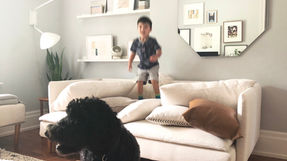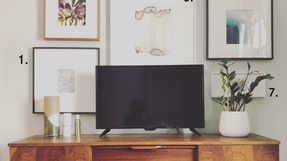A Declutter Blogger's Review of Netflix's Tidying Up With Marie Kondo

This post contains affiliate links. See disclosure.
Netflix has strategically released it's eight episode series, Tidying Up With Marie Kondo, on January 1st, the day most of us are coming to grips with the aftermath the holidays have wreaked on our homes.
Full disclosure: as I'm not a TV critic, I didn't have early access to the show. So, I'm writing this review after having watched just half the series, all while putting away our Christmas decor and folding laundry. I strongly recommend finding something productive to do as you watch, unless you want to experience some serious tidying FOMO.
Tidying Up feels like a cross between Terrace House and Hoarders lite (instead of hoarders, it's average Americans). Nevertheless, if you're a minimalist or are already drinking the KonMari Kool-Aid, many of these homes will strike you as painfully overstuffed.
In one episode, a mom literally trips over clutter in her toddler's room (could-happen-to-anyone level clutter); in another, a retired couple tackles a lifetime's worth of never-before-decluttered baseball cards and Christmas ornaments.
If you've read the book, The Life-Changing Magic of Tidying Up, you'll find each episode is like a case study, following one family's journey through the decluttering steps outlined in the book. If you haven't, don't sweat it. No prior knowledge of the book or the KonMari method is required; Marie Kondo explains it anew each episode.
Kondo, the creator of the KonMari method and star of the show, is cheerfully zen; she's a petite and remarkably svelte Japanese woman with glossy, well-kempt hair.
Like a pint-sized, Asian Mary Poppins---warm, but prim and proper---she swoops in with her Japanese-to-American translator to tackle the clutter of a new, likeable American family each episode. Typically donning a meticulously pressed skirt and crisp blouse or sweater set, she's dressed more for a day at the office or Sunday Mass than decluttering.

Image via Netflix.
There's a stark contrast between Kondo's diminutive stature and the average-sized Americans who welcome her into their homes; it seems symbolic of the contrast between the Japanese way of life, which is almost inherently minimalist, and American consumerism and bigger-is-betterism. In one episode, Kondo walks into a family's typical American kitchen and, as if she just saw a unicorn, exclaims "American kitchens are so large!!!"
After being introduced to each family and touring their home's problem areas, Kondo ritualizes the beginning of each decluttering marathon (which takes place over the course of a month) by kneeling with her eyes closed and hands clasped solemnly in her lap. She is surrounded by the family in a moment of silence during which she 'greets' the home and has the family acknowledge and thank it for housing them. If you haven't read the book, this may strike you as a little wacky; if you have, you're probably not surprised.
Each episode follows the decluttering journey of a different, likeable, all-American family and the structure is similar to the book, right down to the order in which to attack different the types of clutter: clothing, followed by books, then documents, 'komono' (kitchen, bathroom, miscellaneous), and lastly sentimental items.
For each category, Kondo has each family pile everything they own in one place, enabling them to see it all (there's nothing like seeing a massive pile of all your shit to make you spiral into a vortex of guilt and shame).

Image via Netflix.
Kondo states "only when confronted with what you have, do you realize what you need to do." She's the frickin' Yoda of decluttering! The piles have a powerful effect on those she aids; this radical idea of piling everything in one place and painstakingly going through each peace individually, keeping only what 'sparks joy,' is likely what made her simple book so popular, in the first place. Then, instead of carelessly tossing aside what doesn't make the cut, clients are encouraged to gently handle each piece, thanking it for its service.
Kondo is known for anthropomorphizing clothing. If you've read the book, you probably remember raising a brow at her advice to fold your socks: "The socks and stockings stored in your drawer are essentially on holiday. They take a brutal beating in their daily work, trapped between your foot and shoe, enduring pressure and friction to protect your precious feet. The time they spend in your drawer is their only chance to rest. But if they are balled up they are always in a state of tension, their fabric stretched and their elastic pulled." While this sounds hokey at first (I remember laughing out loud when reading this), gratitude and mindfulness are at the core of this practice. It's like meditation for your closet and maybe it's the antidote for our mindless materialism. That being said, you'll never catch me folding my socks!

Image via Netflix.
Marie Kondo doesn't come dressed to get her hands dirty, and for the most part, she doesn't. After instructing each family on the framework of her process, sticking around long enough for them to make their first pile, and instructing how to discern whether a material thing 'sparks joy,' she leaves. They deal with the nitty-gritty themselves, then she returns to check in on their progress and the finished product.
The structure of each episode is identical, with each one divided into chapters (it feels almost deliberately organized, even for a formulaic home improvement series). The only thing that changes are the people being helped and the situations that led to their clutter overwhelm. In the first episode, it's a young family who can't find the time for home upkeep; other episodes involve empty nesters attempting to clear out decades worth of clutter, a widow coping with how to let go of her late husband's stuff and an expectant couple literally trying to make room for their baby on the way.


Images via Netflix.
There are Kondo-isms aplenty, which provide for (unintentional) humor. When a mom with toddlers asks how to manage the onerous task of folding all of her clothes into tiny rectangles that stand upright in her drawers (a staple of the KonMari method), Kondo suggests the woman include her kids. Giving an example from her own home, she states "kids love folding...we fold clothes like reading stories at bedtime." Sometimes you find yourself thinking out loud "B!#$%, are you for real?".
For me, the most enjoyable part of the show is when you get a glimpse into the lives of real people following the KonMari method. Embroiled in an argument about whether or not to keep the extra hangers born of their decluttering efforts, a man tells his wife: "Really? A bin full of hangers bring you joy?".
Spoiler alert: each episode ends with increased marital or familial satisfaction and the revelation that with less there can be more value and enjoyment found at home. It’s enough to make you want to quit couples therapy and clean out the basement instead!
Marie Kondo's mandate is to 'spark joy through tidying' and it seems, through this series, that that's something she's able to achieve. Each episode, you witness the mounting enjoyment each family experiences through the process of decluttering and the end result.

Image via Netflix.
The verdict?
Not quite binge-worthy. But, there's something soothingly familiar about this type of PG-rated voyeurism...kind of like House Hunters or Queer Eye.
If you're like me and would rather declutter your own home than watch others declutter theirs, this may not be for you. But, if you're totally lost about where to begin and need a kick in the pants (errr...some inspiration), this may be a good show to have on in the background as you tackle that basement or walk-in-closet.
Tidying Up is the perfect background show---you know, the kind that doesn't require your full attention and is best enjoyed while you put away your laundry or solve quadratic equations. If you've overindulged during the holidays and want some subliminal inspiration to kick start your diet/exercise resolution, maybe staring at Kondo's 23 inch waistline will do the trick?
Have you seen Tidying Up With Marie Kondo, yet? What did you think of it? Let me know in the comments below!
If you've seen the show and thought to yourself "I could really use my own little Marie Kondo," consider a KonMari consultant. They actually exist! If you're in the Toronto area, my Instagram friend, Michele Delory (pictured below with Marie Kondo, herself), is an official certified KonMari consultant.

Look out for my upcoming posts: The Easy Declutter Checklist and Tips For A No-Spend Month.
You May Also Enjoy
To be notified each time there's a new post on the blog and for a free copy of my printable declutter checklist, please subscribe!
If you enjoyed this post, please share it with a friend or pin it for later!


























slot, judi slot, link slot, situs judi slot, slot gacor terpercaya, judi slot, slot deposit tanpa potongan, judi slot, slot mudah menang, slot terpercaya, agen slot, slot terpercaya, situs slot gacor, daftar slot, Toto Slot Gacor, link slot, slot online, slot gacor terpercaya, situs slot gacor, link daftar slot, daftar slot, link slot gacor, link slot gacor, link slot, Slot Online Toto, link toto slot, slot via dana, slot qris gacor, slot gacor, daftar slot, slot 4d, link toto slot, situs slot, slot, daftar slot, slot, slot gacor server thailand, akun pro thailand, situs judi slot, situs slot, daftar slot, judi slot gacor, link slot, situs slot, toto slot 4d, situs slot, slot qris termurah, slot deposit via qris, slot…
slot gacor , daftar slot , toto slot , slot 4d , slot deposit via dana , slot via qris tanpa potongan , slot gacor , daftar judi slot , situs toto , link toto slot , slot , daftar slot , slot , link slot ,
slot gacor , daftar slot , toto slot , slot 4d , slot deposit via dana , slot via qris tanpa potongan , slot gacor , daftar judi slot , situs toto , link toto slot , slot , daftar slot , slot , link slot ,
slot online , slot gacor terpercaya , slot server thailand , slot gacor server luar , slot , daftar slot gacor , situs slot , link slot , situs slot , slot maxwin , situs gacor , link gacor , link slot , slot terpercaya , daftar slot , situs slot , slot gacor terpercaya , judi slot , link slot , slot terpercaya , daftar slot online , situs slot gacor , slot gacor terpercaya , slot gacor terbesar , slot gacor 4d , situs toto , slot qris tanpa potongan , slot deposit qris , link slot , daftar situs slot , daftar situs slot , situs slot , link slot , daftar slot gacor , daftar slot , situs judi slot , slot server luar , slot thailand online , link toto slot , slot gacor , situs slot , slot online , daftar slot gacor , slot gacor , daftar slot , situs toto togel , slot qris gacor , slot pakai qris , link slot , daftar slot gacor
google 优化 seo技术+jingcheng-seo.com+秒收录;
Fortune Tiger Fortune Tiger;
Fortune Tiger Fortune Tiger;
Fortune Tiger Fortune Tiger;
Fortune Tiger Slots Fortune…
站群/ 站群
gamesimes gamesimes;
03topgame 03topgame
EPS Machine EPS Cutting…
EPS Machine EPS and…
EPP Machine EPP Shape…
Fortune Tiger Fortune Tiger;
EPS Machine EPS and…
betwin betwin;
777 777;
slots slots;
Fortune Tiger Fortune Tiger;